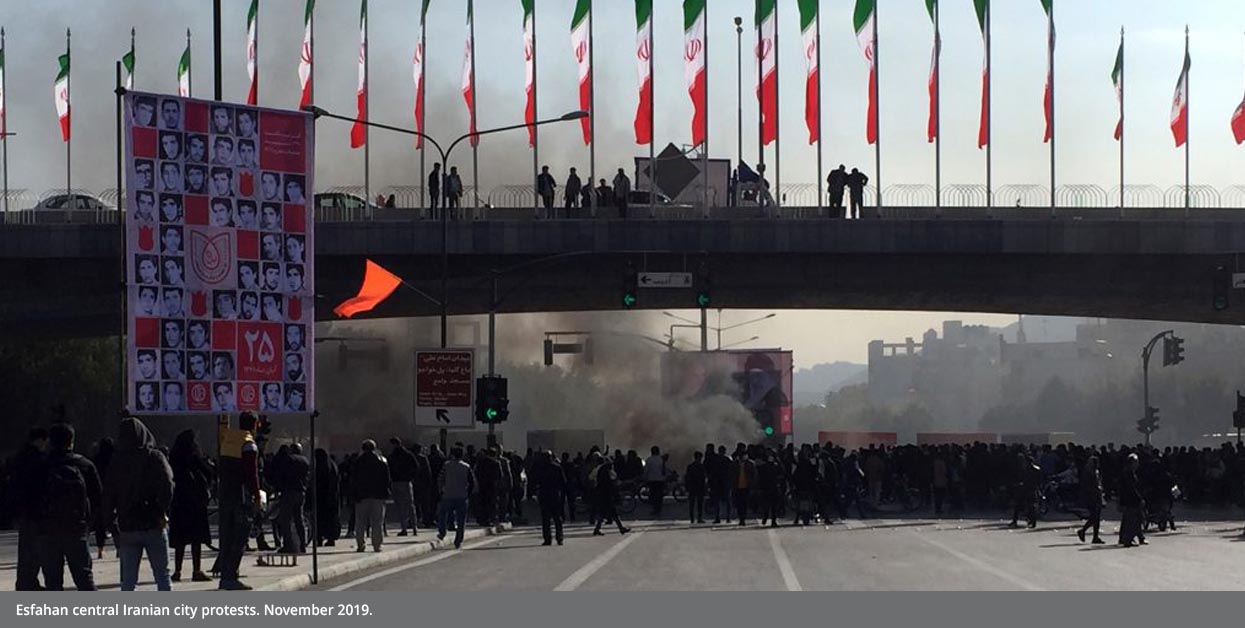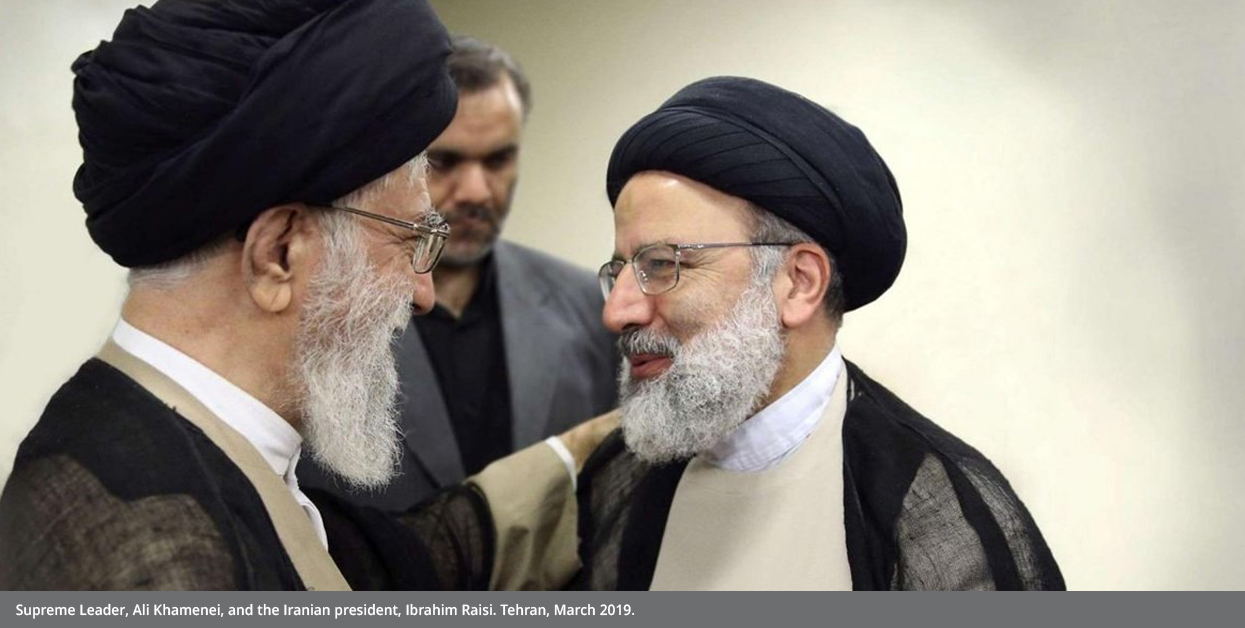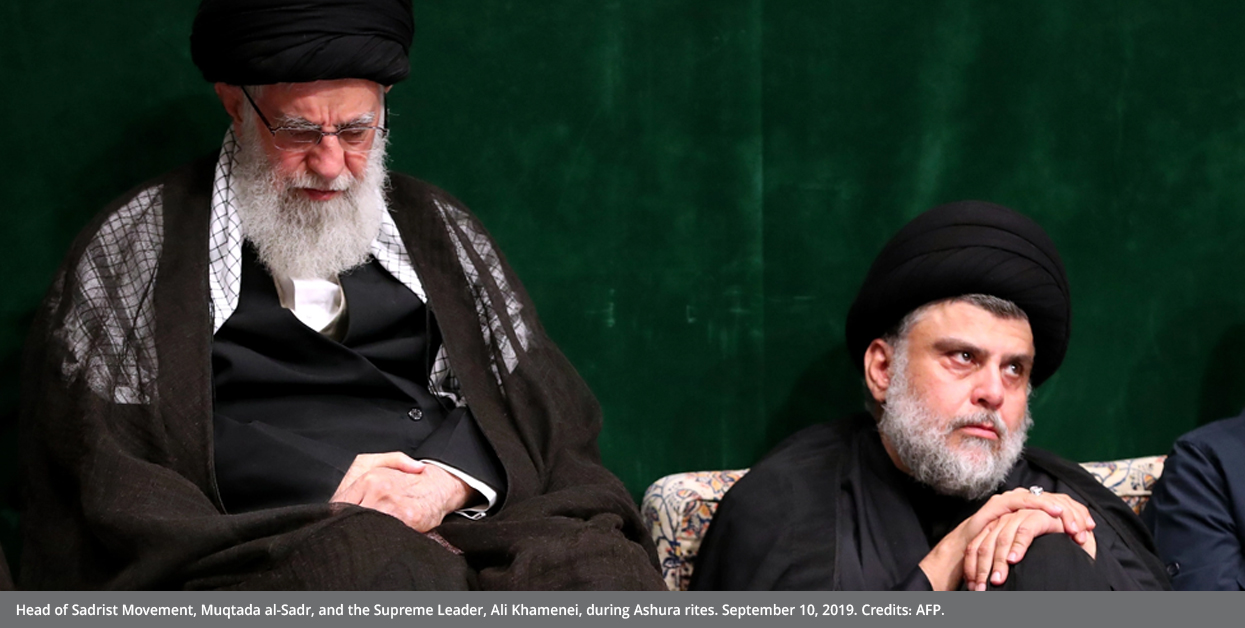How the Supreme Leader’s Illness Affect the Iranian Regime during the Protests?
Policy Analysis | This analysis tackles the challenges that are facing the Iranian regime, in light of reports which said that Supreme Leader, Ali Khamenei, has a "serious" disease, at the time the protests in several Iranian cities intensify as days pass. The paper examines the role of the Supreme Leader, and how his death may affect in light of the country's unfavourable major events.
by Dr. Shehata Al-Arabi
- Release Date – Nov 29, 2022

The impact of the protests in Iran is intensifying after the death of the young woman Mahsa Amini in mid-September, as she was arrested by the "Morality Police". The protests and anti-regime gatherings continue to be held in several cities, especially in the capital, Tehran.
The increasing worry of the Iranian regime, due to the escalating protests, is evident by the Supreme Leader's speech, where he described the death of the young Iranian woman, on October 3, as a "bitter incident", then he returned on November 26 to threaten the protesters by saying "The rioters will pay the price for their actions, and will undoubtedly be dealt with".
The protests coincide with reports about the Iranian leader's illness. According to several sources, the Supreme Leader cancelled all meetings and abstained appearing to the public, after it was said that he underwent surgery due to a blockage in the intestine, and having a "serious" disease, prior his appearance on September 17 to refute those reports about his health. But Supreme Leader is 83 years old, therefore, the Iranian regime is facing many speculations about the death of the Supreme Leader's central role in the future, as he is the highest constitutional authority in the state. Such speculations come especially during the current period, in light of unfavourable conditions for Iran, coming from more than one angle:
First: The hard economic conditions that the country suffers from due to international sanctions and the economic situation in the world. This makes the Iranian public opinion unwilling to accept any "manipulation" or violations in the process of choosing Khamenei's successor. Any violation of such a kind could lead to a huger anger amidst the public opinion.
Second: The Iranian youth, who did not witness the 1979 revolution, and whose believe in its slogans, figures, and proposals, is weak. The Iranian youth may view the position of the Supreme Leader as outside the context of the current age, especially since the protests that Iran has witnessed since 2009 all raised slogans against the Supreme Leader and his absolute powers.
Third: Iran did not experience the succession of the Supreme Leader but once only in 1989, when the slogans of the Islamic Revolution were still strong and present in the people's conscience. The country was just emerging from a devastating war with Iraq, the matter that made it easy to pass Ali Khamenei's succession to Khomeini, despite his lack of condition of being a religious reference. However, the circumstances are now significantly different, making thunge be more difficult for the Iranian regime.
Fourth: Talking about the Supreme Leader's illness and the possibility of his death at any time, comes at a time when the country is witnessing a continuous opposition movement since what was known as the "Iranian Green Movement" in 2009, then the protest against raising fuel prices in 2019, and later the current protests over the death of Mahsa Amini. thus, many experts indicate that the frequency of these protests is a sign of the low acceptance rates of the regime among the public.

Though Iran's constitution sets out the mechanism for selecting the new supreme Leader, if Ali Khamenei dies, through the Assembly of Experts, and although this constitution sets out the conditions that are important to meet such, Khamenei's death will represent an unprecedented test for the Iranian regime at the current stage.
The Supreme Leader: The Iranian Regime's Corner Stone
The Supreme Leader position is not just an ordinary job in the Iranian political system, based on the idea of "Welayat al-Faqih" (or the rule of the religious scholar), rather, the Supreme Leader the essence of this system, its strong pillar, the axis of its movement, and the main centre of gravity in it. This is evident from the powers granted to him as per the constitution, as he is responsible for setting the public policies after consulting with the Expediency Council and the General Command of the Armed Forces. His capacities include declaring war and peace, and public alert, besides appointing, sacking, and accepting the resignation of: Constitution Scholars Council, the highest official in the judiciary, the head of the Radio and Television Corporation, the Joint Command chief of staff, the Islamic Revolutionary Guard Corps commander-in-chief, the senior commands of the armed forces and the internal security forces. He is also competent to resolve disputes and regulate relations between the Three Authorities, ratifying the inauguration and removal of the president pursuant to specific conditions, in addition to issue amnesties or commuting the sentences of the convicted.
These Supreme Leader's massive powers stem from the idea that he is the deputy of the absent Imam, ruling on behalf of the Imam's until the Imam return, according to the theory of Welayat al-Faqih, brought by Ayatollah Khomeini, who considered that Welayat al-Faqih is a divine mandate, as he says that "God made the Prophet the guardian of all believers, and after him the Imam was a guardian. This same guardianship and governance exists with the Faqih".
This means that the death of the Supreme Leader is the death of the regime's axis, its thinking and mastermind, not just the death of another political figure, regardless his centre of gravity, including the president of the republic. Khamenei's death concerns not only Iranians, but also Shiites who believe in Iran's Welayat al-Faqih worldwide, as well as those who take Khamenei as a reference for tradition in the region and the world.
Regime Disputes Eruption
The current Supreme Leader came to his position since 1989, after Khomeini's death, which means that he has been in this position for about 33 years. This has consolidated his control and dominance over the regime, and also his ability to direct such regime and control its interactions and conflicts.
Khamenei did not hold the rank of "Grand Ayatollah" (the highest religious scholar degree) which is necessary to hold office after Khomeini's passed the way. The Iranian constitution was even amended, dropping requiring the Supreme Leader be a followed religious reference, so that he could succeed Khomeini. Khamenei worked to overcome his lack of charisma, and his lack to the religious and jurisprudential status of his predecessor, Khomeini, by surrounding himself with a network of advisers in his office, as well as a network of personal representatives in the government, army, Revolutionary Guards, and other state and community institutions.
This made Khamenei the first decision-maker in the regime, regardless of the who the Iranian president may be, and whether he is a reformist or a conservative.
Moreover, over the past decades, Khamenei was been able to prevent the collapse of the Iranian regime from within, due to the deep disputes between its forces, institutions, and factions, through his role, as an arbiter between the authorities, and his ability to intervene in a timely manner to tip the balance of one current at the expense of the other.
Therefore, the supreme Leader's death, at any time, could lead to dislocation within the regime, and the emergence of its disputes on the surface, especially since it is not only related to disputes in political positions and orientations; these disputes extend to the conflict over financial and economic interests.
Disagreement on the Successor
Although talk of Supreme Leader Khamenei's illness has been raised more than once over the past years, there is still no consensus on his successor. Despite numerous reports of Mojtaba Ali Khamenei will succeed his father, and in spite of the father's efforts to set Mojtaba to take the post for years, by consolidating his powers within the regime. But Mojtaba's lack of political experience, and fear of the idea of inheriting the position, in addition to the problems and objections of succession could raise at the Iranian level, represent Major obstacles to his father's succession.
In addition, there are other figures competing with Mojtaba such as Hassan Khomeini, grandson of Ayatollah Khomeini, former President Hassan Rouhani, and former head of the judiciary Sadeq Larijani. There are also those who point to the possibility of taking over the position by the current President Ebrahim Raisi, who is close to the Supreme Leader and one of his loyal men, especially with reports that talk about the support of the Revolutionary Guards, which expressed itself as twenty-four current and former commanders of the Iranian Revolutionary Guards signed an open letter publicly praising Raisi, praising his recent speech to the UN General Assembly.

The problem facing the regime in Iran, in the death of Khamenei, is that the Revolutionary Guards support his son Mojtaba to succeed him, while moderate or reformist currents support Hassan Khomeini or Hassan Rouhani. This would create a strong conflict within the governing institutions, especially since it is a matter of the person who controls the regime, directs its policies, and controls its financial, military, and security joints.
In light of the challenge posed by popular protests to the Iranian regime, this may push the regime to avoid these disputes over the successor to the Supreme Leader, in order to avoid the weakness of the regime, and the collapse that could lead to.
The Challenge of Wilayat al-Faqih
There has been a debate for many years about the theory of Welayat al-Faqih, which represents the basis of the Iranian regime, and what the Supreme Leader derives his powers from, especially with regard to the limits of the powers of al-Wali al-Faqih (the ruler, the scholar) his nature, whether he is an individual or an institution, or whether his role is religious, political, or both, besides other complex questions.
Khamenei's presence over the past decades was an obstacle to this controversy against the debate on his issue or the debate touching the red lines. However, his death at any time would strongly reignite the debate over Welayat al-Faqih, and allow counter-arguments to emerge, not only outside Iran but also inside it. There is a current inside Iran called the "Mahdist Movement" represented by former Iranian President Ahmadinejad, this movement believes in the imminent return of Mahdi and what this would mean, as well as reducing the powers of the Supreme Leader, whose role is limited to in ruling on Mahdi’s behalf, according to Twelver Shi'i belief. There are also some Iranian Shiite clerics who believe that the source of the Supreme Leader's powers is the people and not God, including Hossein Montazeri, who died in 2009.
Furthermore, there are many theses put forward by Shiite jurists and religious references on Wilayat al-Faqih, contrary to the nature of Wilayat al-Faqih, on which the Iranian regime is based thereon, especially the Arab Shiite religious references. These ideas are expected to emerge strongly after the death of Khamenei, including: the vision of the Najaf Hawza in Iraq, which limited Wilayat al-Faqih to collecting al-Khums (the 20% tax) on behalf of the Imam, in addition to some other calculation matters aside from politics. The theory of "the caliphate of the nation and the supervision of the religious references" presented by Ayatollah Muhammad Baqir al-Sadr, is based on a new vision on the relationship between the jurist and the state, through what Sadr called the "line of Caliphate and line of Believe" in Islamic society: the line of caliphate represents the temporal worldly aspect which the nation represents, while the line of believe represents the religious aspect, represented by prophets, infallible imams and scholars. Al-Sadr called for the separation of the two lines, stressing that they may not be assumed by one person, because the qualities of caliphate and believe can only be combined by infallible imams.
Since Khamenei assumed the post of Supreme Leader, the influence of the IRGC has increased, especially after the war with Iraq, as the IRGC has become a partner in running the country, having the upper hand in choosing the next leader, which will direct the Supreme Leader Iranian regime to be a military rule, run by the IRGC.
The Conflict between Najaf and Qom Hawzas Intensifies
There is a historical conflict between Najaf hawza in Iraq and Qom hawza in Iran over the limits of influence on Shiites in the world. Although the Qom Hawza has emerged significantly since 1979, and Najaf Hawza has declined for many reasons: the latter has remained a challenge to Qom, especially as it adopted a contrary view of Welayat al-Faqih, as mentioned above. Iraqi religious authority Ali al-Sistani is considered one of the most important Shiite authorities in the world, who is competing with the Qom authority, because he does not recognize the political mandate of Wali al-Faqih, limiting his role on religious matters only.
The possibility of conflict between Qom and Najaf, after the death of Khamenei, is increasing. this challenge is represented against Qon during the recent period by the Iraqi cleric al-Sadr, especially after the statement of the Shiite authority Kazem al-Haeri in August 2022, in which he announced the retirement of the "duties of the religious reference" and his call for Muqtada al-Sadr's supporters to imitate the Iranian leader Ali Khamenei, despite the fact that he, i.e. al-Haeri, was seen as the successor of al-Sadr. With this statement, Al-Haeri has escalated the dispute between the two religious references, by praising the Qom at the expense of Najaf.

It was remarkable in Muqtada al-Sadr's statement, in which he announced his retirement from political life, that "despite the resignation of al-Haeri, Najaf is the largest headquarters of the religious references, as is always the case," which confirms that al-Sadr relies on the strength of the Najaf in confronting Iran, and that he believes in its progress over the Qom.
Aspects of domestic and Foreign Influence
Talking about Khamenei's illness, directly or indirectly, affects the Iranian regime's policy at the domestic and foreign levels and in more than one respect, as follows:
1- Adopting a hard-line approach to the popular protests: The IRGC sees itself as the dominant force if Khamenei dies. Therefore, it shows great militancy against popular protests, which it considers directed against IRGC and his potential hegemony in post-Khamenei Iran.
2- Managing disputes over the successor: It is possible that the Iranian factions, including the Revolutionary Guards, will work to manage their succession over the succession of the Supreme Leader, so that a clash does not lead to the loss of everyone, especially in light of the popular protests.
3- Postponing decisions on foreign issues: Talking about the Supreme Leader's illness makes the centres of power in Iran unable or unwilling to decide on major foreign issues, foremost of which is the nuclear file, while waiting what will happen at the leadership level. Perhaps this is the reason behind freezing of nuclear negotiations, and also behind Tehran's lack of enthusiasm to reach an understanding with the international powers concerned with reviving the 2015 nuclear agreement.
4- Freezing regional files: in the sense of preventing solutions to these files, as is the case in Lebanon and Yemen in particular. Perhaps even tending to escalate the situation in the region, in order to divert attention from what is happening inside Iran, whether at the level of protests or at the level of movement within the regime, in preparation for the death of the Supreme Leader, or after his actual death.
In light of the above, it can be argued that Khamenei's death will represent the greatest challenge facing the Iranian regime since the death of the leader of the Islamic Revolution, Ayatollah Khomeini in 1989, so the regime's passing the test will serve as an important indicator of its ability to withstand and continue, while the regime’s stumbling may be a prelude to its gradual decline. In any case, the IRGC will have the highest and most influential word to say in determining the course of the Iranian regime in the coming period, because it is the dominant party on the economy and military power, as well as the media.
Dr. Shehata Al-Arabi
A Researcher on Middle east
 العربية
العربية